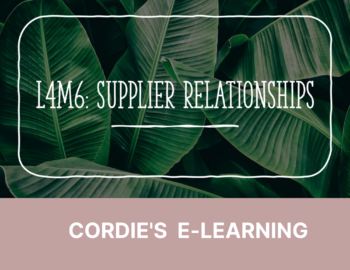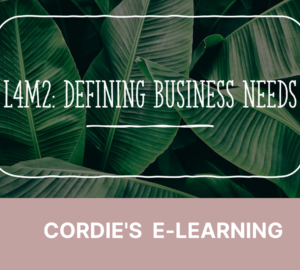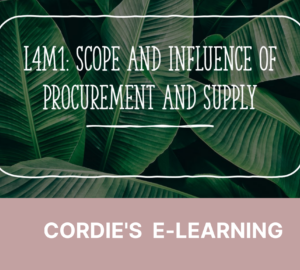L4M6 e-Learning
$32.91
Description
1.0 Understand the dynamics of relationships in supply chains
1.1 Differentiate between different types of commercial relationships in supply chains
- Internal and external relationships
- The relationship spectrum
- The relationship life cycle
1.2 Appraise portfolio analysis techniques to assess relationships in supply chains
- Matrices to identify supply, supplier and purchaser positioning
- Developing action plans
1.3 Identify the competitive forces that impact on relationships in supply chains
- Sources of competitive advantage
- Competitive forces: sources of competitive rivalry, bargaining power of buyers and suppliers, threat of new entrants and potential substitutes
- STEEPLE factors that impact on supply chains (social, technological, economic, environmental, political, legislative and ethical)
1.4 Compare the sources of added value that can be achieved through supply chain relationships
- The link between relationships as a process and the achievement of added value outcomes
- Sources of added value: pricing and cost management, improving quality, timescales, quantities and place considerations in procurements from external suppliers
- The link between organisations in supply networks
2.0 Understand processes and procedures for successful working with stakeholders
2.1 Analyse the purpose of organisational procedures and processes in sourcing goods and/or services
- Achieving value for money
- Supplier identification, assessment and selection
- Selection and awarding criteria
2.2 Compare team management techniques to ensure positive stakeholder relationships
- Positive relationships through positive contributions
- Overcome resistance
- Identify conflict and coping processes
- Cross-organisational teams
- Stages of team development – forming, storming, norming, performing
2.3 Compare the practical considerations of stakeholder management
- Accurate cost modelling
- Reduced impact of price fluctuations
- Early supplier involvement in product and/or service development
- Knowledge transfer and access to innovation
- Common metrics to drive change for both organisations
- Improve risk management and continuity of supply
2.4 Identify the processes for terminating stakeholder relationships
- Reasons for termination
- The process of termination
- Timing
- Relationship impacts – amicable vs. hostile
- Legal considerations – finances, confidentiality, IPR, security, employee rights
- Succession issues – continuity of supplies
3.0 Understand the concept of partnering
3.1 Analyse the concept of partnering and where it is a suitable approach
- The three types of partnering
- Partnering vs. ‘traditional’ contracting agreement
- The drivers for partnership sourcing
- Advantages for purchaser and supplier•
- High spend
- High risk
- Technically complicated supplies
- New services
- Fast-changing technology
- Restricted markets
3.2 Appraise the process of partnership implementation
- Identify items potentially suitable for partnership sourcing
- ‘Sell’ the philosophy to senior management and other functions of the organisation
- Define the standards that potential partners will be expected to meet
- Establish joint commitment to the partnership
- Reviews and audits
3.3 Identify the reasons why partnerships fail
- Poor communication
- Lack of senior management support and trust
- Lack of commitment by one or both parties
- Poor planning
- Lack of value-added benefit
- Changes in the market
- Corporate cultural differences
- Logistics and distance barriers




